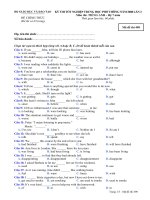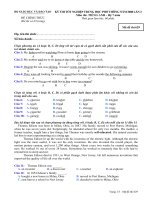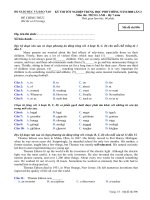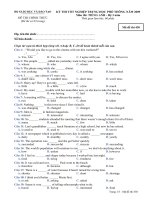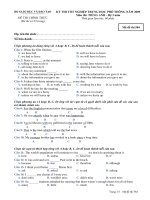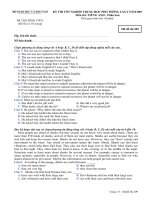Paul Siklos MA, BSc, MB, MRCP, Stephen Olczak BSc, MD, MRCP (auth.)-Preparation for MRCP Part II-Springer Netherlands (1983)
Bạn đang xem bản rút gọn của tài liệu. Xem và tải ngay bản đầy đủ của tài liệu tại đây (4.79 MB, 190 trang )
PREPARATION FOR
MRCP Part II
PREPARATION FOR
MRCP Part II
Paul Siklos and
Stephen Olczak
Published, in association with
UPDATE PUBLICATIONS LTD., by
1983 .MTP PRESS LI.MITED
a member of the KLUWER ACADEMIC PUBLISHERS GROUP
BOSTON / THE HAGUE / DORDRECHT / LANCASTER
...
"
Published in the UK and Europe,
in association with Update Publications Ltd., by
MTP Press Limited
Falcon House
Lancaster, England
British Library Cataloguing in Publication Data
Siklos, Paul
Preparation for MRCP Part II.
1. Medicine-Problems, exercises, etc.
I. Title
II. Olczak, Stephen
610'.76
P834.5
ISBN -13: 978-94-011-7303-2
e- ISBN -13: 978-94-011-7301-8
DOl: 10.1007/978-94-011-7301-8
Published in the USA by
MTP Press
A division of Kluwer Boston Inc
190 Old Derby Street
Hingham, MA 02043, USA
Library of Congress Cataloging in Publication Data
Siklos, Paul.
Preparation for MRCP part II.
Includes index.
1. Internal medicine-Examinations, questions, etc.
I. Olczak, Stephen.
II. Title.
III. Title: Preparation for M.R.C.P.
part II.
IV. Title: Preparation for MRCP part 2.
[DNLM: 1.
Medicine-Examination questions. W 18 S579p)
RC58.S541983
616'.0076
83-13213
ISBN-13: 978-94-011-7303-2
Copyright
©
1983 Paul Siklos and Stephen Olczak
Softcover reprint of the hardcover 1st edition 1983
Reprinted 1985
All rights reserved. No part of this publication may be reproduced, stored in
a retrieval system, or transmitted in any form or by any means, electronic,
mechanical, photocopying, recording or otherwise, without prior permission
from the publishers.
CONTENTS
Preface
Introduction
Written section
Clinical section
Table of normal values
Section 1: Case Histories
Questions
Answers
Section 2: Slide Interpretation
Questions: Colour slides
Aids for X-ray interpretation
Questions: X-rays
Answers
Vll
1
2
4
12
15
16
35
63
64
85
108
125
Section 3: Data Interpretation
Aids for interpretation of cardiac catheter data
Questions
Answers
154
156
167
153
Index
179
THE AUTHORS
Paul Siklos, MA, BSc, MB, MRCP
Consultant Physician, West Suffolk Hospital, Bury St Edmunds and
Newmarket General Hospital;
Recognized Clinical Teacher, University of Cambridge, UK
Stephen Olczak, BSc, MD, MRCP
Honorary Senior Registrar in Medicine, Addenbrooke's Hospital,
Cambridge, UK
PREFACE
This book is directed towards post-graduates who have passed Part I
of the examination for Membership of the Royal College of Physicians
and are preparing for Part II. However, it is hoped that physicians at
all stages of their careers will find some parts that interest them. Most
of the material has appeared in the Hospital Update series, 'Preparation
for MRCP', but this has been modified and expanded; many useful
points arising from correspondence relating to the series have been
included, and the authors would like to express their thanks to those
who have written. It is not intended that this should be used as a work
of reference, although there is detailed discussion of some subjects.
Only the written part of the examination is dealt with in detail, but
the introduction contains hints on tackling the clinical sections which
the authors hope the candidates will find valuable. There is, however,
no substitute for clinical practice under supervision. The questions in
Vll
PREFACE
the written section of the examination require short answers so that
marking may be easy and objective. This book contains questions
similar to those that may be encountered in the examination, but the
answers have been expanded as a basis for discussion. It is hoped that
this will encourage the candidate to read around the subjects covered,
and the authors recommend that the questions are used as a basis for
group discussion, as answers other than those in the text may be
considered.
There are sections dealing with case histories; data for interpretation
(including advice on interpretation of cardiac catheter data); colour
slides of clinical material and slides of radiographs with examinationorientated hints on interpretation of the radiographs of the chest,
abdomen and skull.
The authors gratefully acknowledge contributions from: Dr Nick
Boon; Mr Neil Rushton; Dr Carol Seymour; Dr David Stone; Dr
Richard Greenwood; and Dr Geoff Tobin, as co-author of the first 1\
articles in the Update series. We would also like to thank Dr David
Rubenstein for his help and advice in the preparation of the articles for
Hospital Update. The authors are particularly grateful to Dr Ray
Godwin for advice about the radiographs presented, and for the hint~
on interpretation of X-rays of the chest, abdomen and skull.
The authors would also like to thank Samantha Loftus and Lesley
Stellitano for typing the manuscript, and Marcia Thorburn for the
line drawings.
Finally, they would like to express their thanks to Mr Phil Johnstone
of MTP Press Ltd for his encouragement and patience.
January, 1983
Vlll
INTRODUCTION
The MRCP (UK) examination is an entrance examination designed to
select those who are suitable for higher specialist training in general
internal medicine and its related specialities. The achievement of this
diploma is essential in order to progress to higher training and a career
in hospital medicine. Those who pass the examination will have a firm
basic knowledge of medicine; will be able to take a history, and
examine a patient in a professional and accurate manner; and will be
able to plan a rational course of management for patients presenting
with common problems. Many successful candidates have commented
that the examination is similar to the MB Final examination but that
mistakes are more heavily penalized and a greater degree of professionalism is required.
The examination is divided into 2 parts. Part I was introduced in
1968 as a screening examination, because prior to this each candidate
1
INTRODUCTION
had a clinical bedside test and as the number taking the examination
increased there was a considerable strain on resources. The Part I
examination consists of 60 multiple choice questions, and in addition
to filtering out those candidates suitable for progressing to Part II it is
the only part of the examination to test a wide range of factual
knowledge. It has been shown that those who pass Part I by a narrow
margin perform less well at Part II than those who passed the Part I
examination more convincingly.
The candidate is not eligible to enter for Part II of the examination
until he has completed a period of at least 30 months of approved
clinical experience following graduation. Of this 18 months is postregistration experience, and 12 of these months must be spent in posts
that include the emergency care of patients (either children or adults)
acutely ill with general medical conditions. Rather than inspect and
approve each training post the College requires that a candidate who
presents himself for Part II should produce two testimonials from
Fellows of the Colleges or from Members of 8 years standing. The
sponsors testify that the candidate has the necessary experience and
suitable character, and that he is ready to take Part II.
The Part II examination is divided into two parts, the written and
the clinical separated by about a month. The candidate must pass the
written section of the examination before proceeding to the clinical
part, but the pass may be so borderline that bonus marks from the
clinical examination will be required in order to produce a pass for the
whole of Part II.
WRITTEN SECTION
Factual medical knowledge has been tested in Part I of the examination
and this part asks the candidate to solve clinical problems, to interpret
data and to comment on projected material (radiographs and clinical
photographs). Written essays were abandoned because of the unreliability of the marking due to examiner variability, the limited range of
subject matter which can be tested and the demands made on the
examiners' time. The questions are produced by examiners and submitted to a Board in London. Some are selected and refined, and then
passed to the Colleges in Edinburgh and Glasgow where they are
further criticized before being put into the bank. The questions are
often refined still further before being used. The questions generate
answers (as opposed to multiple choice questions) and the questions
2
INTRODUCTION
are designed so that the answers should be short, objective and easily
corrected. Acceptable answers with appropriate marks have been
drawn up and irrelevant answers receive no marks. A penalty may be
incurred for suggestions which are likely to be harmful to the patient.
Case Histories (Grey Cases)
There are 4 or more compulsory questions to be discussed in" 55
minutes. Each states the history, physical signs and results of investigations. The questions are phrased so as to elicit brief answers that can
be marked objectively. Typical questions would be 'List 3 probable
diagnoses', 'Suggest 4 investigations which would be helpful in the
diagnosis'. Maximum marks would be awarded to answers which have
been agreed by the Board as being the best response. All answers
contain potentially the same number of marks, and it seems, therefore,
reasonable to suggest a sensible answer that you are not sure about
rather than to leave a question unanswered.
Some of the information given in the Case will be irrelevant but
none should be actually misleading. It is often useful to concentrate on
aspects of the Case for which there is an established list of causes (e.g.
the presence of clubbing, haemoptysis, etc). Any diagnosis must take
account of these. Remember that rare presentations of common
diseases are commoner than the common presentation of a rare disease,
and in general it is your ability to deal with common diseases that is
being tested.
Data Interpretation
There are 10 sets of data to be interpreted in 45 minutes. The material
includes biochemical, endocrinological and haematological profiles,
electrocardiograms, lung function studies, cardiac catherization data,
analysis of urine and cerebro-spinal fluid, all usually preceded by a
brief clinical abstract. The questions again call for brief, objective
answers and the preferred answer receives maximum marks. You must
be fully conversant with the normal ranges of values for commonly
used investigations.
Projected Material
A slide (or pair of slides) is shown for 90 seconds. A bell then rings and
a further 30 seconds is allowed before the slide changes. Candidates
are asked to answer brief questions on each slide by writing on the
3
INTRODUCTION
combined question and answer sheet provided. There may be a brief
history accompanying the slide and questions may be asked about the
documentation of abnormalities shown, likely diagnosis or differential
diagnosis, likely presenting symptoms etc. There are 20 slides, about a
quarter of which are radiographs, and these may include arteriograms,
myelograms or barium studies. There is usually a peripheral blood film
or bone marrow aspirate and a histology slide. Seating in the lecture
theatre is arranged so that each candidate has a good view of the screen
and the pictures are of a high standard. A picture of an optic fundus
would be preceded by a normal picture to demonstrate photographic
artefacts. It is worth being familiar with the appearance of common
dermatological conditions.
CLINICAL SECTION
Those who pass the written examination proceed to the viva, and to
the short and long cases. Approximately a quarter of those taking the
written Part of the exam will fail but the failure rate of the clinical Part
is not disclosed. It is likely, however, that the failure rate is high, and
this may be because candidates have insufficient competence, knowledge or experience. However, many fail because of poor presentation
and lack of technique. These are areas that can be considerably improved by practice. When face to face with the examiner the following
general points are worth considering.
(1) Appearance is very important.
During the clinical section you will meet 3 pairs of examiners
and first impressions are vital. Dress should be conservative, and
club and old school ties avoided. Smell should be neutral.
(2) Try to relax and impress the examiner with your quiet confident
ability.
This implies that you function well in stressful situations, and
will make a good hospital doctor. A candidate may possibly fail
because the examiners feel that he is just not suitable to be a
consultant physician and Member of the College despite otherwise adequate performance.
(3) However, do not be over-confident and dogmatic particularly
when discussing controversial issues.
You are being tested on general clinical medicine, and not on
the latest breakthrough in an obscure sub-speciality with which
you happen to be conversant.
4
INTRODUCTION
(4) Never argue with the examiners even though you 'know' that
you are correct.
(5) You should demonstrate that you know the commonest causes
of conditions.
However, if you are confident you can start with a rare but
treatable cause which is not to be missed. Always try and talk
from general to specific and from common to rare.
(6) Avoid abbreviations.
A string of apparently unconnected letters is annoying and confusing and may also be misleading e.g. MI may be mitral incompetence or myocardial infarction, PID - pelvic inflammatory
disease or prolapsed intervertebral disc and RIF may mean right
iliac fossa or right index finger.
Oral examination
This is often the first confrontation between examiners and examinee,
and is often very informative for the former and nerve-wracking for
the latter. There are 2 examiners who each conduct an interview of
approximately 10 minutes (20 minutes in total). At least 3 or 4 topics
are covered and each examiner marks all the time, and at the end of
the 20 minutes each writes down his mark before further discussion.
Because factual knowledge has been fully assessed in previous sections
the viva concentrates mainly on testing the candidate on the management of medical emergencies, basic scientific principles and the ability
to deal with specific clinical situations. An increasing emphasis is being
placed on sociological and psychological aspects of patient care, and
the examiner may take the opportunity of asking your opinion on
topical aspects of medical ethics. The candidate may sometimes be
asked to complete a form saying where he is working and what job he
is doing. The first question may then relate to the appropriate speciality
or unit. A question to an SHO in Neurology may be 'Discuss the
appliances available to help the rehabilitation of a stroke patient'
rather than a request for neurological facts. Topical problems include
drug addiction, alcoholism, patient compliance and problems of the
elderly. It is useful to read the leading artkles of the British Medical
Journal, Lancet and New England Journal of Medicine for a few
months before the viva.
Ensure that you arrive early enough to be fully composed by the time
you are called in. First impressions are important, and if it is obvious
that you are disorganized enough to be late for the interview the
5
INTRODUCTION
examiners will conclude that your attitude to medicine is equally
disorganized. You will also lack the confidence required to be seen at
your best. A neatly dressed candidate who looks alert, intelligent and
enthusiastic will have an immediate advantage over someone who is
slovenly and lethargic. Take the proffered chair politely, and exchange
any pleasantries which may be offered. The first question is usually
straightforward and gives time to develop rapport. Consider the following points:
(1) Do not repeat the question while thinking of an answer. This is
a most irritating habit.
(2) Try and plan your answer so that the most important aspects
are mentioned first, particularly if the question is voiced in
general terms. For example, in reply to the question 'Discuss the
treatment of thyrotoxicosis' it is important to start 'There are 3
choices - anti-thyroid drugs, radio-iodine and surgery' and then
discuss each in more depth.
(3) In the event of not understanding a question say you are not
clear exactly what is being asked and the examiner will re-phrase
the question. If you ask him to repeat the question he may well
do so and you will be no further forward. In addition you will
have wasted time and probably irritated the examiner.
(4) You must admit early on that you know nothing about the
subject under discussion if this is the case. This will eventually
be deduced and valuable time which could be used discussing a
more familiar subject will be lost. However, it is important that
you do not 'pass' on too many questions!
(5) Be prepared to discuss a pathological specimen or radiograph. It
is usually wise to describe the exhibit as accurately as possible
before further discussion.
(6) Try and concentrate on what you are saying and avoid vague
and meaningless phrases. Your ability to communicate as well
as your medical knowledge and judgement is being assessed.
(7) It pays to keep the discussion as simple as possible unless you
are very sure of the subject. The mention of rare eponymous
syndromes (of which the examiner may well not have heard)
often causes antagonism.
At the end of the allotted time leave graciously after thanking the
examiners. Such an exit leaves a good impression and may sway
judgement in borderline circumstances.
6
INTRODUCTION
Short Cases
You are now introduced to a different pair of examiners and asked to
demonstrate your skill in eliciting and interpreting physical signs. The
examiners have no knowledge of your previous performance and again
an initial good impression is vital. The total time allotted to the short
cases has been increased from 20 to 30 minutes because the examiners
feel that this is one of the best areas to assess clinical skills. It is the
section that candidates fear most, and there is no substitute for practice.
The examiners hope to cover 4 out of the 5 major systems and also
show 2 or 3 'spot cases'. Each examiner marks all the time independently, and marks are written down at the end before conferring.
The examiners are assessing your technique so a certain amount of
showmanship is called for. Be methodical, accurate and comprehensive
and make sure the examiner knows what you are doing. Make a point
of inspection because although you may have noticed the signs to be
seen on inspection, it is important that you are seen doing so. Every
action should be clear and simple and look well practised. You must
make up your mind about a sign on first (or at worst) second examination, as there is nothing worse than having to watch repeated halfhearted demonstrations of physical signs. A sign is either abnormal or
it is not - avoid words such as minimal, slight, minor, a hint of
cyanosis, clubbing etc. Never say that you searched for a physical sign
but could not elicit it. It would be incompetent to miss palpating an
enlarged spleen, but to sugg~st that you examined carefully and still
missed it makes matters worse. Some candidates find that giving a
running commentary of findings saves time but others prefer to sum
up at the end. If you feel confident you may state a diagnosis, otherwise
summarize the positive findings.
It is well known that some examiners tend to be aggressive (the
hawks) and some benign (the doves}. Hawks and doves are often paired
together, and candidates often try to direct attention towards the dove
who appears more sympathetic. However, remember that both examiners are marking all the time. The examiner will often introduce the
patient by name and will provide a short case history. He will then
give instructions as to what he wishes you to do. These instructions
are brief and should be explicit but it is important to understand what
is required so ask for clarification if there is any doubt. Examination of
the 'heart' is different to 'the cardiovascular system' but if asked to do
the former it is worth commenting, for the sake of completeness, that
7
INTRODUCTION
Table Possible short cases: a list based on candidates' recent
experiences
Cardiovascular
Common congenital heart disease
(ASD, VSD etc.)
Valvular disease of the heart
Prosthetic valves
Coarctation of the aorta
Hypertrophic cardiomyopathy
Jugular venous pressure
Respiratory
Chronic obstructive disease
Clubbing
Fibrosing alveoli tis
Gastrointestinal
Hepatomegaly
Splenomegaly
Ascites
Chronic liver failure
Tongue
Primary biliary cirrhosis
Haematology
Lymphadenopathy
Purpuric rash
Fundoscopy (see Hurst, G. (1979).
Examination of the eye. Hospital
Update, 1979,5,1137)
Diabetes
Hypertension
Optic atrophy, papilloedema
Retinal artery/vein occlusion
Cataract
Endocrine
Thyroid swelling, hypo- and
hyperthyroidism
Acromegaly
Gynaecomastia
Diabetic complications
Cushing's syndrome
Turner's syndrome
Neurology
Chronic neurological syndromes:
Multiple sclerosis
Dystrophia myotonica
Motor neurone disease
Syringomyelia
Parkinsonian syndrome
Tabes dorsalis
Friedreich's ataxia
Muscular dystrophies
Visual field abnormalities
Nystagmus
Pupillary abnormalities
Horner's syndrome
Diplopia
Cranial nerve palsies (III, IV, VI, VII)
Cerebellar syndromes
Bulbar/pseudobulbar palsies
Dysarthria
Hydrocephalus
Gait disorders
Peripheral neuropathy
Peripheral nerve injuries
Wasting of the small muscles of the
hand
Musculoskeletal
Osteoarthrosis
Gout
Rheumatoid disease - arthritis and
systemic manifestations
Scoliosis
Ankylosing spondylitis
Collagen disease:
Scleroderma, CREST syndrome
SLE
Dermatomyositis
Marfan's syndrome
Neurofibromatosis
8
INTRODUCTION
Table (continued)
Dermatology
Common skin lesions and those
associated with systemic disease
Nephrological
Neuropathic bladder
Uraemia, shunts, fistulae
Polycystic kidneys
you would look at the hands, ankles and so on but spend time only on
the heart itself. Similarly, it is worth trying to get as much information
from other systems as possible but time should not be wasted on doing
other than the examiners ask. You should try and greet the patient by
his name (if told) and ask permission to examine the part concerned.
The examiner may then say 'of course he does not mind you examining
him, that is why he is here'. However, it is important to approach
patients with respect and treat them as fellow humans rather than as
objects to be examined. The candidate may have elicited all the signs
correctly but still fail because of a rude or callous approach to the
patient. Remember to use euphemisms for diseases such as cancer,
syphilis or epilepsy when talking within earshot of a patient. Do not
ask the patients any leading questions which may help in the diagnosis
as this is supposed to be achieved by physical examination alone.
It is very useful when preparing for the examination to make a list
of possible short cases and to write down the physical signs which may
be associated with each condition (see the Table). Plan a methodical
approach to each problem, e.g. if you are shown a patient with acromegaly and asked to demonstrate evidence of any complications you
should be able quickly to assess visual fields, look for median nerve
compression and so on. It is particularly useful to rehearse patient
examination and presentation in the presence of a critical audience
(your Consultant or Senior Registrar). This will ensure that your
method of examination is not only correct, logical and thorough but
also that it is carried out with style and professionalism.
Long Case
You are given access to a patient for 60 minutes and are required to
take a full history, make a clinical examination and perform any
bedside or side-room tests (such as urinalysis) which you consider
appropriate. At the end of that time you will meet a further pair of
examiners one of whom does most of the examining, but again each
9
INTRODUCTION
marks individually and they confer at the end. The examiners will
require an accurate, concise history; a brief synopsis of the physical
signs (which you may be asked to demonstrate) and a presentation of
the problems of diagnosis, further investigation and management. The
examiners will be interested in a presentation of the patient's problems,
not only physical but also mental and social.
The patients chosen for the examination tend to be new Out-patients
and In-patients rather than the 'MRCP exam chronic cases', who are
practised at churning out their 'classical' (but rare) history and demonstrating a bewildering array of physical signs. A working diagnosis has
usually been reached and the patients often present more than one
problem. There may be very few physical signs, and the aim of the long
case is to assess technique of history taking and presentation and
solution of patients' problems. For these reasons traditional examination shortcuts such as the opening gambit 'What do the doctors say is
wrong with you?' are less relevant. Approach the patient as you would
a new case in the clinic rather than change your routine to attempt to
play 'the long case game'. However, when you have completed your
assessment and formed your own impression, it is worth asking the
patient if he knows his diagnosis and what investigations he has had
done.
It is very important to ensure that you have at least 10 minutes for
thought before meeting the examiners. During this time the main
points can be mentally rehearsed, because this is the only situation
where you have a chance to run the interview, by steering the conversation towards subjects about which you are familiar. It is important
to take a problem orientated approach and say how the illness affects
the patient. You must anticipate any questions about differential diagnosis, further investigations and future management of the patient. It
is very important to make your presentation interesting.
General Points
The clinical section tests command of clinical skills and enables the
examiner to assess your attitude towards patients. It is very important
to have practice in talking to and examining patients with as wide a
variety of diseases as possible. A busy general medical job is ideal for
this. It soon becomes obvious when a candidate is at ease with patients
and can confidentially elicit physical signs, and this approach comes
automatically to those with a wide range of clinical experience. Be sure
that you can wield a patella hammer and use an ophthalmoscope. It is
10
INTRODUCTION
often worth taking your own equipment to the examination as you will
be familiar with it, and will not have to compete with other harassed
candidates for ward items. It is certainly worth having in your possession a hat pin for testing visual fields, an orange stick for eliciting the
plantar response and a tape measure.
It is difficult to plan specific reading for the clinical part of the
examination as the field is so extensive. There is no substitute for
seeing patients in a clinical setting and presenting such patients to a
critical audience. However, many candidates have found the following
of considerable help:
1. Beck, E. R. Francis,]. L. and Souhami, R. L. (1982). Tutorials in Differential
Diagnosis. 2nd edn. (Edinburgh: Churchill Livingstone)
2. Mason, S. and Swash, M. (1980). Hutchison's Clinical Methods. 17th edn.
(London: Bailliere-Tindall)
3. Ogilvie, C. (1980). Chamberlain's Symptoms and Signs in Clinical Medicine:
an Introduction to Medical Diagnosis. 10th edn. (Bristol: Wright)
4. Pappworth, M. H. (1985). Primer of Medicine. 5th edn. (Sevenoaks:
Butterworths)
5. Rubenstein, D. and Wayne, D. (1985). Lecture Notes on Clinical Medicine.
3rd edn. (Oxford: Blackwell Scientific)
6. Zatouroff, M. (1976). A Colour Atlas of Physical Signs in General Medicine.
Wolfe Medical Atlases, No. 16. (London: Wolfe)
The following papers relating to the examination and examination
technique are also useful:
1. Cohen, J. A. (1982). Postgraduate Diplomas MRCP Part II. Br. ]. Hasp.
Med., 28, 361
2. Constable, T. ]. (1975). A guide to preparing for the MRCP (UK) exam.
Hospital Update, 635
3. Shinton, N. K. (1978). How to take an examination viva. Br. Med. ]., 2,
1694
4. Smith, R. (1982). Becoming a member of the Royal College of Physicians;
trial by MCQ. Br. Med. j., 2,1341
5. Stokes, J. F. (1979). How to take a clinical examination. Br. Med. j., 1: 98
6. Symposium MRCP: 1977 (1978). Br. Med. ]., 1,217.
11
INTRODUCTION
TABLE OF NORMAL VALUES
(approximate SI conversion to conventional units is given in brackets)
Haematology
(note g/dl = mg/100 ml and 1 x 10 911 = 1000 cells/mm 3 )
Haemoglobin (Hb) Male 13.5-17.5 g/dl
Female 12.5-16.5 g/dl
Packed cell volume (PCV) 0.40-0.541/1
Mean cell volume (MCV) 77-93fl
Mean cell haemoglobin concentration (MCHC) 29-35 g/dl
Reticulocytes 0.2-2.0% (10-100 x 109 /1)
Leucocyte count (WCC) 4.0-11.0 X 109 /1
Differential leucocyte count: Neutrophils 2.0-7.5 x 109/1 (40-75%)
Lymphocytes 1.5-4.0 x 10911 (20-45%)
Monocytes 0.2-0.8 x 10911 (2-10%)
Eosinophils 0.04-0.4 x 10 911 (1-6%)
Basophils
<0.01-0.1 x 109/1 (1%)
9
Platelet count 150-400 x 10 /1
Serum B12 > 130 ng/l
Serum folate 3-13 J.Lg/1
Red cell folate> 150 J.Lg/l
Plasma Urea and Electrolytes
Sodium
Potassium
Bicarbonate
Glucose
Urea
Creatinine
132-142
3.4-5.0
22-30
3.5-9.0
up to 7.5
35-125
mmo1/1 (= mEq/l)
mmo1/1 (= mEq/l)
mmo1/1 (= mEq/l)
mmo1/1 ( x 18 = mg/dl)
mmo1/1 ( x 6 = mg/dl)
J.Lmo1/1 ( x 0.01 1 = mg/dl)
Liver and Bone Tests
Total protein
Albumin
Calcium
Phosphate
Bilirubin (Total)
Alkaline phosphatase
SGPT (ALT)
63-83 gil (-;.-10 = g/dl)
30-44 gil
2.20-2.60 mmo1/1 ( x 4 = mg/dl)
0.80-1.40 mmo1/1 ( x 3 = mg/dl)
up to 17 J.Lmo1/1 ( x 0.058 = mg/dl)
30-135 Ull
7-40 Ull
12
INTRODUCTION
Urinary Urea and Electrolytes
Sodium
Potassium
Urea
Creatinine
Creatinine clearance
Calcium
Phosphate
50-200 mmolj24 h
20-60 mmolj24 h
330-500 mmolj24 h
9.0-16 mmolj24 h
90-110 mljmin
2.8-7.5 mmolj24h
22-32 mmolj24 h
Serum Protein Electrophoresis
Transferrin
IgG
IgA
IgM
Alpha-1-antitrypsin
Haptoglobin
2.2-3.8 gil
6.0-13.0 g/l
0.8-3.7 g/I
0.4-2.2 g/I
0.9-1.8 g/I
0.5-2.6 g/l
Arterial Blood Gases
Hydrogen ion
pH
P0 2
Pco 2
36-45 nmoljl
7.35-7.45
9.3-13.3kPa (x7.5=mmHg)
4.6-6.0 kPa
Miscellaneous Biochemistry
Acid phosphatase
Cortisol
Creatine kinase
Male
Female
Growth hormone, fasting
Insulin, fasting
Iron
Male
Female
Prolactin
Male
Female
SGOT
Thyroxine (total T4)
Triiodothyronine (Total T3)
TSH
Uric acid
up to O.7U/l
280-650 nmoljl ( x 0.036 = Jlg/dl)
24-195 U/l
24-170U/I
14-32 Jlmoljl (x5.6=Jlg/dl)
10-28 Jlmoljl
< 150mU/1
<300mU/1
<35U/l
65-145nmoljl (4-12 Jlg/dl)
1.0-2.8 nmoljl
<4.0mU/1
0.12-0.45 mmoljl ( x 17 = mg/dl)
13
INTRODUCTION
Cerebrospinal Fluid
Protein
Glucose
Cells - Lymphocytes
0.1-0.4 gil
> 70% of simultaneous blood glucose
<3/mm3
14
Section 1
CASE HISTORIES
CASE HISTORIES
01
A IS-year-old girl presents as an emergency with a 12-hour history of
fever, confusion, diarrhoea and vomiting. Her parents when questioned say that for the previous two months she has complained of
diarrhoea with no blood or mu(.Us and has lost weight in spite of a
good appetite. Her mother has insulin-dependent diabetes.
On examination, she is confused and agitated with no skin rash.
Other observations are: temperature 40°C; pulse 140 per minute, irregular; blood pressure 90160 mmHg; abdomen normal; rectal examination normal, soft faeces.
Investigations show:
Haemoglobin IS gldl
White cell count 16 x 109 /1
Platelets 400 x 109 /1
Sodium 143 mmol/l, potassium 3.2 mmol/l, urea 18 mmol/l,
creatinine 140 J.Lmol/l
Plasma glucose 6.S mmol/l
Calcium 2.92 mmol/l, phosphate 1.9 mmolll, albumin 43 gil
Questions:
(1) What is the most likely diagnosis?
(2) What urgent investigations would you request?
(3) Outline your management of this condition.
02
A 16-year-old girl, who one week previously returned from a holiday
in southern Spain is admitted with a 2-day history of watery diarrhoea,
fever, vomiting and headache. She had had unprotected sexual intercourse while abroad, but had been menstruating normally for the 3
days prior to admission. The other members of the party had not had
similar symptoms.
She is confused with a temperature of 40°C, flushed and toxic, with
bilateral conjunctivitis. Her skin shows a diffuse erythematous macular
rash resembling sunburn. Her blood pressure is 80 mmHg systolic with
a pulse rate of 130 per minute. There is no clinical evidence of pneumonia.
Investigations show:
Hb 13.Sg/dl
16
CASE HISTORIES
White cell count 17 x 109 /1 (90% neutrophils)
Platelets 40 x 109 /1
Plasma sodium 129 mmol/I, potassium 3.2 mmol/I, urea 15 mmol/I,
creatinine 220 Jlmol/I, glucose 6 mmol/I
Lumbar puncture shows clear fluid containing 3 red cells and 2 lymphocytes. CSF glucose is 4 mmol/I
Cultures of blood and stool on 4 occasions are negative. A high vaginal
swab grew staphylococcus aureus. Monospot test is negative and a
chest radiograph normal.
Questions:
(1) What is the likely diagnosis?
(2) What would be your initial and long-term management?
A 55-year-old woman with well controlled insulin-dependent diabetes
of 10 years' duration presents with a history of postural dizziness. She
denies palpitation. She suffered from a myocardial infarction complicated by left ventricular failure 6 months previously, and since then
has been taking frusemide 40 mg and amiloride 10 mg each twice daily.
Her pulse is 110 per minute regular. Supine blood pressure is 135/
90 mmHg and standing blood pressure 95/70 mmHg. There is bilateral
background retinopathy and deep tendon reflexes at the ankles are
absent. Examination is otherwise normal.
Investigations show:
Plasma sodium 120 mmol/I, potassium 3.3 mmol/I, bicarbonate
29 mmol/I, urea 14.5 mmol/I, creatinine 125 Jlmol/I; glucose 12.9 mmol/l.
Questions:
(1) Suggest 2 possible mechanisms to explain her symptoms.
(2) How would you investigate these?
(3) What treatment might you suggest for each?
17
Q3
CASE HISTORIES
Q4
A 61-year-old man with no significant past medical history developed
an influenza-like illness associated with low back pain of moderate
severity. His systemic symptoms cleared after 48 hours but he was left
with back pain and diffuse muscle pains in both legs. Five days later he
complains of increasing difficulty in walking because of the leg weakness and is admitted to hospital where he develops urinary retention.
He is alert and orientated with minimal neck stiffness and a temperature of 38°C. He is tender over the lower lumbar spine with
reduction of straight leg raising to 30° bilaterally because of back pain.
The lower extremeties are flaccid, and distal weakness in the arms is
noted. Sensation is normal except for diminished appreciation to pinprick over the dorsum and sole of the right foot. Deep tendon reflexes
at the knees and ankles are absent. No plantar responses are elicited
and anal sphincter tone is diminished. Examination is otherwise normal.
Investigations are:
Chest radiograph normal
Lumbar spine radiograph shows narrowing of L4/5 disc space
Cerebro-spinal fluid:
red cells 25000 /mm 3
lymphocytes lO/mm 3
neutrophils 30/mm3
glucose 5 mmoljl (simultaneous blood glucose 7 mmol/l)
protein 2.8 gil
Questions:
(1) What is the most likely diagnosis?
(2) Give 2 differential diagnoses
(3) Explain why the 2 conditions in Question 2 are less likely than the
condition chosen as the most likely diagnosis.
QS
A 27-year-old unmarried nurse presents with a 3 month history of
episodes of faintness, dizziness and palpitation, usually occurring
shortly after rising in the morning. These episodes were becoming
more frequent. On 2 occasions she had experienced similar symptoms
following a long game of tennis in the late morning but had recently
stopped playing because of weight gain. Five years previously she had
18
